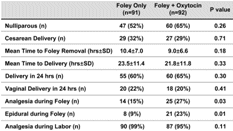Trial of Transcervical Foley Catheter With or Without Oxytocin for Preinduction Cervical Ripening
SMFM 27th Annual Meeting 2007
view the interview video: Induction of Labor
Abstract
Objective: The transcervical Foley catheter (TFC) is a proven and effective mode of cervical ripening. It is common practice to use TFC with simultaneous low-dose oxytocin (OT), under the assumption that this combination results in a higher success of labor induction. Scientific validation of this practice is lacking. We sought to determine if the addition of OT to TFC improves the success of labor induction.
Study Design: This prospective, randomized trial enrolled 200 singleton pregnancies presenting for preinduction cervical ripening. Patients were randomized to receive either TFC alone or TFC plus low-dose OT (to 10mU/min). Providers were not blinded to use of OT and labor was managed according to routine obstetric protocols. The primary outcome of our study was to detect a 20% difference in the proportion of patients delivered within 24 hrs (total n=180). Secondary outcomes were related to vaginal delivery rate, duration of induction, infection, bleeding, and pain management.
Results: Data was available for 183 of 200 patients randomized. Mean gestational age for both groups was 39 wks. There were no significant differences in age, BMI, initial cervical exam, and parity (p>0.05). There were no differences in induction outcomes or vaginal delivery rates between the two groups (Table). Rates of infection and bleeding were also similar. There was a signficantly increased requirement for analgesia during induction for the TFC+OT group.

Conclusion: Addition of OT to TFC does not shorten the duration of induction and has no impact on the likelihood of delivery within 24 hours or vaginal delivery rate, though there is an increased use of analgesia by these patients during ripening. The use of OT in addition to TFC ripening is not justified.
References:
0002-9378/$ - see front matter
doi:10.1016/j.ajog.2006.10.070
American Journal of Obstetrics and Gynecology
Volume 195, Issue 6, Supplement S (December 2006)
S1E4: Dr. Kristina Adams-Waldorf: Pandemics, pathogens and perseverance
July 16th 2020This episode of Pap Talk by Contemporary OB/GYN features an interview with Dr. Kristina Adams-Waldorf, Professor in the Department of Obstetrics and Gynecology and Adjunct Professor in Global Health at the University of Washington (UW) School of Medicine in Seattle.
Listen
AI helps improve detection of congenital heart defects on prenatal ultrasounds
January 31st 2025AI-assisted software improves clinicians' detection of congenital heart defects in prenatal ultrasounds, enhancing accuracy, confidence, and speed, according to a study presented at SMFM's Annual Pregnancy Meeting.
Read More
Study shows a healthy prenatal diet could be upstream obesity prevention strategy
December 26th 2024"Our findings support the recommendation of a healthy diet based on the current guidelines (as measured by the HEI) during pregnancy, since it may reduce patterns of infant growth outside reference ranges."
Read More
